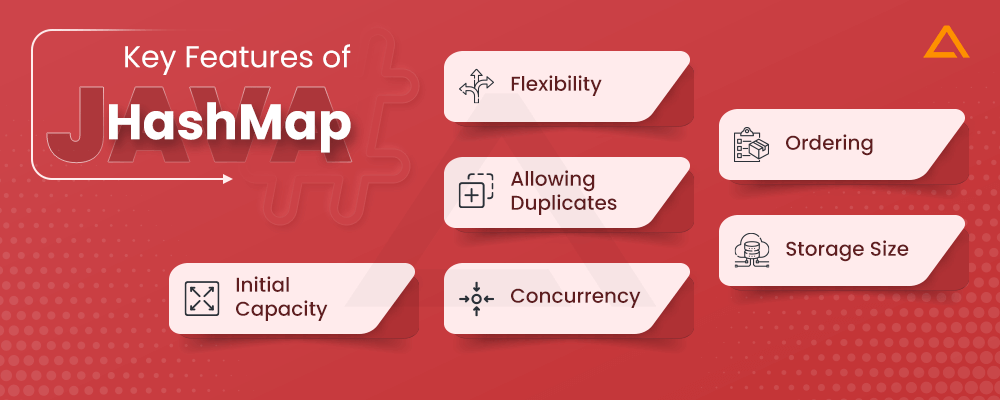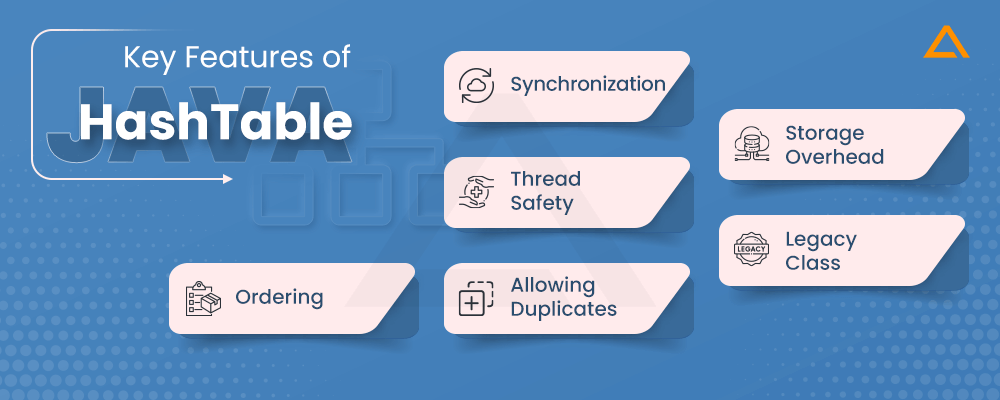Quick Summary:
HashMap vs Hashtable – a comparison of two data structures who share similar functionality but have majorly distinctive features and implementation. Think of HashMap and Hashtable as companions that shine in their own specific use cases instead of two competitors trying to win the same throne. Knowing when to use HashMap over Hashtable and Hashtable over HashMap is important to know when, where and how to deploy them in your Java application. We aim to help make that distinction and selection easier with this guide.
In the vast sea of Java development landscape, data structures are essential building blocks for creating scalable Java applications. Data structures play a significant role in organizing and managing data efficiently.
They provide means to store and manipulate data allowing Java developers to conduct operations such as insertion, deletion, searching and traversal. The Java programming language includes a collection of robust data structures within the Java Collections Framework. Two of the most popular Java data structure frameworks of JCF are – Java HashMap and Hashtable.
To understand why are they so popular and what they have to offer, we need to start off by understanding them in greater detail and then conduct a head-to-head comparison between Java HashMap vs Hashtable.
Let’s begin with HashMap!
📝 In this blog, we’re going to discuss…
HashMap in Java – What is Java HashMap?
A HashMap in Java is a key data structure used for implementing the Map interface. It is also a part of the Java Collection Framework. It is designed for storing key-value pairs for enabling quick retrieval of values based off their associated keys. Each key has a unique hash code that determines the index or bucket where the corresponding values are stored.

Key Features of Java Hashmap
Here are the core features of Java Hashmap that are important to know for evaluating it is a viable data structuring option for your Java project:

- Flexibility – HashMap can use any object as key or value. Keys need to implement equals() and hashCode() You can also keep values as null.
- Ordering – Key/Values stored in the array are in no particular order. Iteration orders can be unpredictable.
- Allowing Duplicates – Although HashMap does not allow key duplication, it supports it for values, so two pairs can end up having the same value.
- Storage Size – You don’t need to pre-allocate storage or set a limit on its size. HashMap is capable of dynamically resizing to accommodate to the changing needs.
- Initial Capacity – Developers can define initial capacity (number of buckets) for improving performance. The default is set at 16.
- Concurrency – HashMap is not optimized or synchronized for multi-threading. There is an alternative known as ConcurrentHashMap that can be used instead.
HashTable Java – What is a Hash Table in Java?
Hashtable in Java is a commonly implemented data structure method that is implemented using the ‘Hashtable’ class. It also provides a key-value pair method of storing data where each key is associated with a value. It is similar to the ‘HashMap’ class but it comes with thread safety as it is synchronized.

Hence, HashTable can allow multiple threads to manipulate a ‘Hashtable’ without worrying about data corruption. It inherits the dictionary class for implementing Map interface. When using HashTable, the developer needs to specify the object that is to be used as a key and the corresponding value you want to be linked to that key. Later, this key is hashed and the outcome of this is a hash code which is used as index where the value is stored inside the table.
Key Features of Java Hashtable
Here are the key features you should know about Java hashtable before choosing it as a possible data structure for your Java project:

- Synchronization – Hashtable methods are synchronized for thread safety in multi-threaded dev environments. All operations like
get(),put(),containsKey()and others are synchronized. - Storage Overhead – There is no defined capacity restriction or limitation but more the space you use up for synchronization, more load on Java’s garbage collector.
- Thread Safety – The reason Hashtable is synchronized is to ensure its thread safety.
- Legacy Class – Hashtable has been a part of Java since Java Development Kit 1.0.
- Ordering – Keys are stored in no logical order but the enumeration of keys or values return them in the order they were inserted.
- Allowing Duplicates – Keys need to be unique in Hashtable, values however can be duplicated.
Hashmap vs Hashtable Quick Tabular Comparison
| Aspect | HashMap | Hashtable |
| Inheritance | Extends ‘AbstractMap’ and implements ‘Map’ | Extends ‘Dictionary’ and implements ‘Map’ |
| Thread Safety | Not synchronized. Not thread safe. | Synchronized. Thread safe. |
| Null Keys | One Null Key | Will throw NullPointerException on null key |
| Null Values | Allows multiple null values | Throws NullPointerException on null values |
| Performance | Fast, Not Synchronized | Slower since all methods are synchronized |
| Ordering | Can’t be figured out | Provides methods for getting keys/values as per their insertion order |
| Initial Capacity | 16 by default, can be adjusted | 11 by default, can be adjusted |
| Load Factor | 0.75 by default | 0.75 by default |
| Fail-Fast Iterators | Yes | Yes |
| Legacy Class | Introduced in JDK 1.2 | Available in JDK 1.0 |
| Accept Duplicate Keys | No | No |
HashMap and Hashtable Similarities
As we can see, most places HashMap and Hashtable are almost identical. Before comparing the differences, let’s take a look at these similarities:
- Both ‘
HashMap’and ‘Hashtable’ are used to implement the ‘Map’ interface that provide a way to associate keys with values. - Both HashMap and Hashtable allow only 1 null key.
- Both HashMap and Hashtable allow the developers to set an initial capacity and load factor when constructing a map.
- Both HashMap and Hashtable make use of fail-fast iterators.
- Both implement Map interface and follow the {K,V} pairing.
- Both store entries in buckets based on the hashcode of the key.
- Both make use of hashing for finding the right bucket location for storing entities.
- Both make use of chaining for avoiding collisions.
- Both allow equivalent constructors allowing initial capacity and load factor to be defined.
- They are both part of Java Collections Framework and implement the Map interface.

Hey!✋
Are you looking to hire Java Developers?
Our experienced Java developers @ Aglowid are here to fast-track your project with tailored solutions.
Hashmap vs Hashtable – Comparison of Java Collection Frameworks
The differences between Hashmap and Hashtable comes in terms of Performance, Sychronization and other such notable features. These differences may not seem like much at first but they make all the difference in how the two data structures in question handle data retrieval and storage. Let’s get right into it:

1. Hashmap vs Hashtable Synchronization
HashMap as we saw, is not synchronized. This also means it is not thread-safe. Multiple threads can easily access HashMap concurrently without any restrictions. This is beneficial from a performance point of view especially in a non-concurrent environment; however, it would need external synchronization for thread safety in multi-threaded environment.
Hashtable on the other hand is synchronized, which means multiple threads won’t be able to modify Hashtable concurrently. This benefits the development process from a thread safety’s point of view but at the same time could lead to performance overhead in single threaded environment.
2. Hashtable versus HashMap Null Values
HashMap allows single and multiple null values since HashMap permits having one key with null value and multiple entries with null values. HashTable on the other hand, does not allow support for null keys or values. So, if a developer attempts to insert a null key or value, HashTable throws a NullPointException.
Hashtable vs HashMap in Java Null Values Code Comparison
Hashtable Code Example
import java.util.Hashtable;
public class Main {
public static void main(String[] args) {
Hashtable<String, String> table = new Hashtable<>();
table.put("key1", null); // null value is allowed in Hashtable
// table.put(null, "value1"); // NullPointerException will be thrown
System.out.println(table);
}
}Output:
{key1=null}Hashmap Code Example
import java.util.HashMap;
public class Main {
public static void main(String[] args) {
HashMap<String, String> map = new HashMap<>();
map.put("key1", null); // null value is allowed in HashMap
map.put(null, "value1"); // null key is also allowed in HashMap
System.out.println(map);
}
}Output:
{key1=null, null=value1}Notable Differences in Hashtable vs HashMap Null Values Handling
| Aspect | HashMap | Hashtable |
| Null Values | Allows null values ‘ map.put(“key1”, null);’ |
Allows Null Values ‘ table.put(“key1”, null);’ |
| Null Keys | Allows one null key ‘ map.put(null, “value1”);’ |
Does not allow null keys ‘ // table.put(null, "value1");’ |
3. HashMap vs Hashtable Inheritance
HashMap is a part of Java Collections Framework and hence extracts the AbstractMap class. This eases and opens up room for extension and customization. Hashtable is a legacy class and is generally considered to be obsolete in modern Java development. Although, it also extends the AbstractMap class it is generally recommended to use alternatives like ConcurrentHashMap for conducting thread-safe operations.
4. HashMap Iterator vs Hashtable Enumerator
The HashMap iterator is a fail-fast iterator, however the Hashtable enumerator is not. If Hashtable is updated in any manner other than iterator’s native ‘remove’method after the iterator is constructed, it will throw a Concurrent Modification Exception.
5. Java HashMap vs Hashtable – Superclass vs Legacy
Hashtable is a subclass of the Dictionary class which has been deprecated in the JDK 1.7 version and is no longer in use. You can rather synchronize a HashMap externally or make use of ConcurrentHashMap. Although Hashtable and Hashmap have differing superclasses, they still implement the same abstract data type – ‘Map’.
When to use: Hashtable versus HashMap
As we saw both HashMap and HashTable are crucial key-value pair data structures that belong to the JCF. However, they have some crucial differences and deciding between the two can be challenging without having a proper guideline as to how to choose one over the other. Let us break it down for you real easy:

Use HashTable over HashMap when:
- Thread Safety is a requirement
- Null Values are not allowed
- You are working with Legay code

Use HashMap over HashTable when:
- Thread Safety is not your primary concern
- Null Values are allowed
- Performance is first priority
- You want extended and customizable functionality

Wrapping up!
This was a quick guide on the difference between hashmap and hashtable in Java data structuring. To sum it up again, ‘HashMap’ offers flexibility and better performance in non-concurrent requirements, making it ideal for situations where external synchronization can be managed.
On the other hand, Hashtable provides intrinsic synchronization, prioritizing thread safety in place of the additional performance overhead it causes. Newer JCF frameworks such as ‘ConcurrentHashMap’ seems to be providing a balanced solution for apps that need concurrency. So, ultimately the choice depends on your project requirements. If you need help understanding your Java project requirements, you can leverage professional IT strategy and consulting services of a reliable IT firm.




